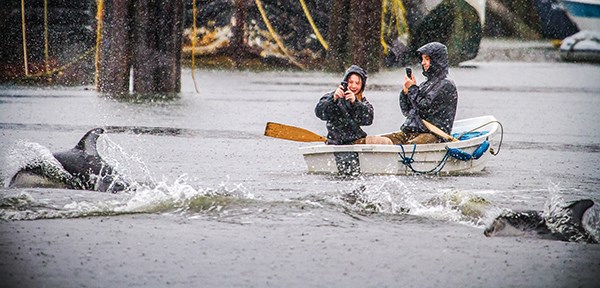Squamish is attracting more dolphins – and it’s all about the potential meals in the water, say marine experts.
A visit by a pod of around 70 dolphins thrilled Sea to Sky corridor residents on Jan. 6, and head cetacean researcher Dr. Lance Barrett-Lennard from the Vancouver Aquarium said the recovery of Howe Sound in recent years has made the area more appealing for dolphins.
“The sightings are reflective of Howe Sound and the Strait of Georgia in general,” he said. “The herring fisheries are better managed than in the past, and there’s much greater spawning of herring in Howe Sound. Covering the pilings in the estuary so that herring spawning was protected from creosote was a surprisingly simple but effective step that was taken.”
Barrett-Lennard added that the lessened presence of industry has helped make Howe Sound a healthier place, but it can take time for dolphins to return.
“With these marine mammals they learn about areas,” he said. “So if an area is poor for a number of years, they stop coming in. When it recovers there can be a lag period before its discovered. They’re often coming to an area for feed so it’s a good sign when they show up.”
Scientist and dolphin researcher Erin Ashe from the Ocean’s Initiative group agreed that it’s a great indicator that Howe Sound and the herring revival is working.
“It may be that Squamish is a becoming a reliable place to find fish,” she said. “In the Broughton Archipelago, where I conduct most of my research, the dolphins have a number of reliable places where they feed on herring or other fish. I understand that a number of groups have been working very hard to restore herring habitat in the area and if that’s the case, the dolphins may be a great indicator to help us understand if those efforts are working.”
Barrett-Lennard said Pacific white-sided dolphins began reappearing in local waters about 10 years ago, and the aquarium has averaged about a half dozen sightings per year of the mammal in Howe Sound.
“It’s rare to see dolphins as far up as Squamish,” he said. “That was quite unusual, they are more often seen near Lions Bay or Gambier Island, so to see them all the way up there is quite cool.”
Ashe said Pacific white-sided dolphins travel in large groups and are full of energy.
“They can be exciting to watch because they can leap high out of the water and engage in stunning acrobatics,” she said. “There is still a lot to learn about the specifics of their behaviour, but it’s clear that they are in constant communication with one another and have highly coordinated movements whether they are hunting for fish, traveling at high speeds in large groups, or avoiding killer whale attacks.”
Barrett-Lennard explained that the dolphins can be as long as 2.5 metres and can live into their 40s. He added they travel in groups of hundreds and he’s personally seen them travel in groups of thousands. He said they are distinguishable by having a taller fin and more energy than porpoises.
He added that the aquarium is always seeking information on sightings of marine animals of any kind in Howe Sound and would love to get more information from Squamish residents.
“We’ve run a program at the aquarium for 12 years called the BC Cetacean Sighting Network,” he said. “And we encourage the public to send in their sightings. It helps give us a good idea to detect change and we pass along our info to governments. We can always use more sighters.”
To report sightings of marine wildlife, visit www.wildwhales.org or call the hotline at 1-866-I Saw One (472-9663).



